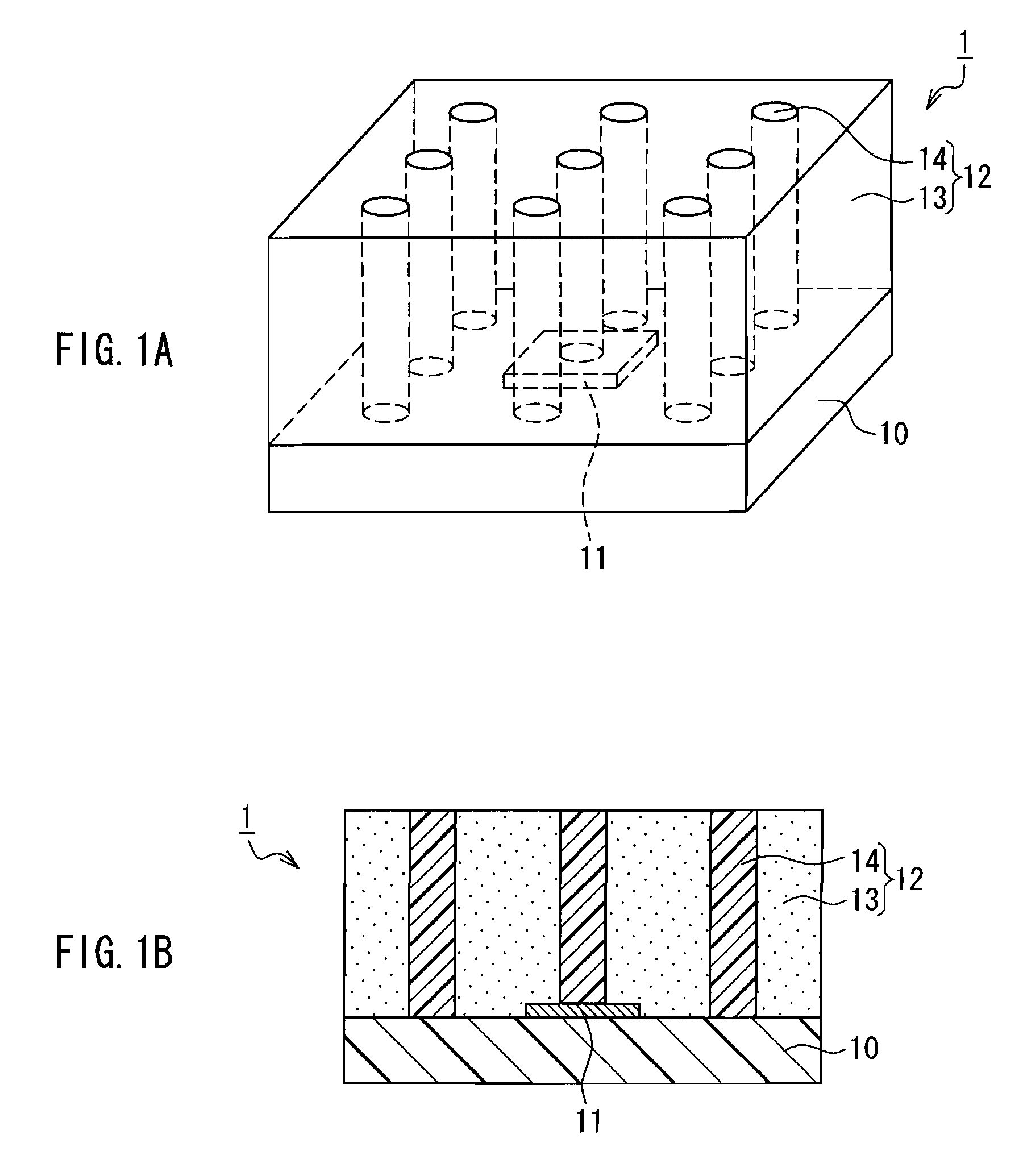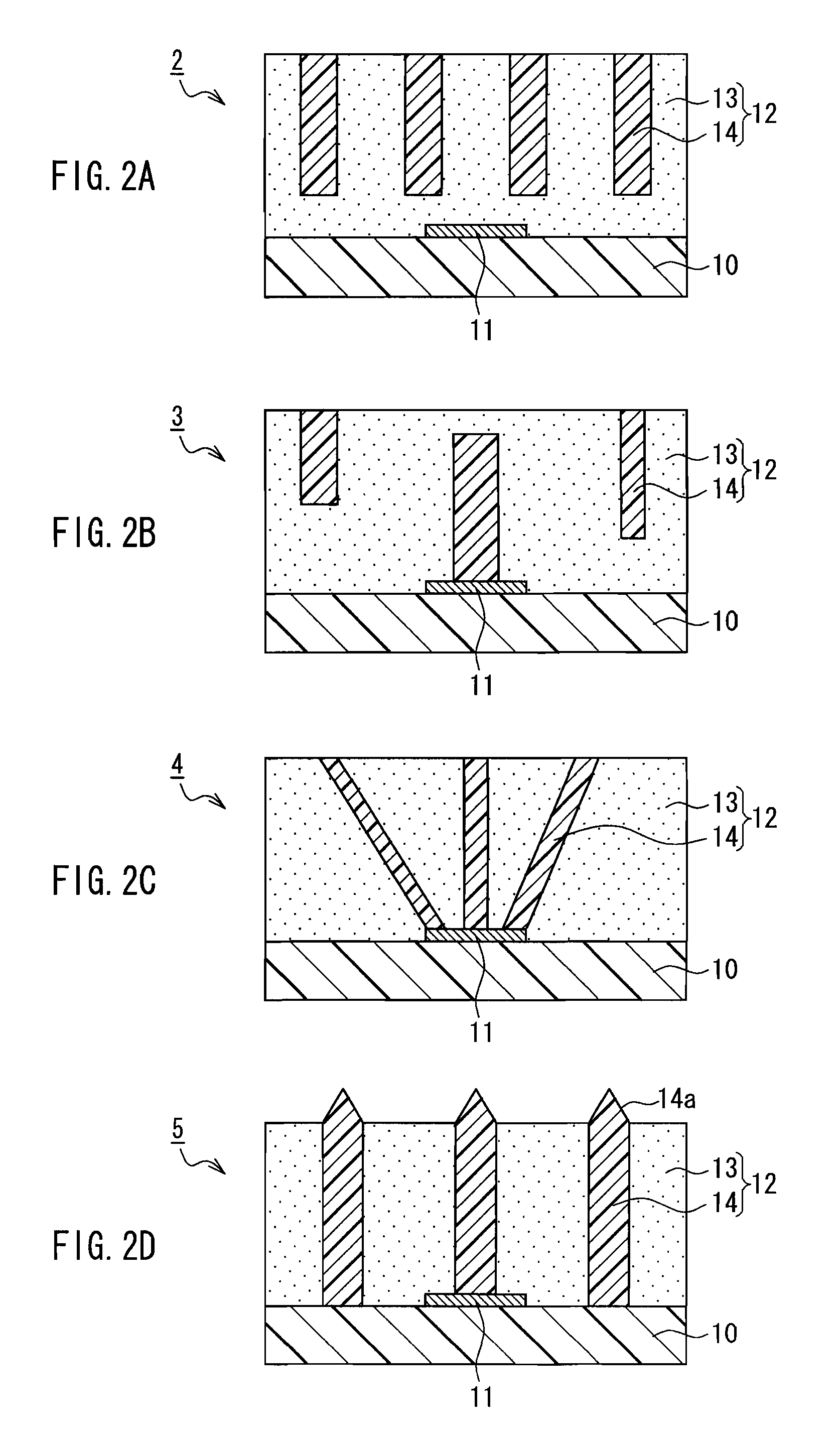Light-emitting device and method for manufacturing the same
- Summary
- Abstract
- Description
- Claims
- Application Information
AI Technical Summary
Benefits of technology
Problems solved by technology
Method used
Image
Examples
embodiment 1
[0047]FIG. 1A is a schematic perspective view showing a light-emitting device according to Embodiment 1 of the present invention, and FIG. 1B is a schematic cross-sectional view of the light-emitting device shown in FIG. 1A.
[0048]As shown in FIGS. 1A and 1B, a light-emitting device 1 includes a base 10, a light-emitting element 11 placed on the base 10, and a wavelength converting layer 12 that covers the light-emitting element 11. The wavelength converting layer 12 includes a wavelength converting portion 13 containing a wavelength converting material for converting a wavelength of light from the light emitting element 11, and nine light guide portions 14 made of a light-transmitting material. Each of the light guide portions 14 extends from a light-emitting element 11 side to a light extraction side (top surface) of the wavelength converting layer 12. With this configuration, it is possible to prevent the light from the light-emitting element 11 from being reflected by the wavelen...
embodiment 2
[0054]FIG. 3A is a schematic perspective view showing a light-emitting device according to Embodiment 2 of the present invention, and FIG. 3B is a schematic cross-sectional view of the light-emitting device shown in FIG. 3A. As shown in FIGS. 3A and 3B, in a light-emitting device 6, the wavelength converting layer 13 has a three-layer structure, in which a red phosphor layer 131, a green phosphor layer 132, and a blue phosphor layer 133 are laminated sequentially from a base 10 side. Further, an ultraviolet LED is used as the light-emitting element 11. With this configuration, it is possible to prevent a phosphor in the red phosphor layer 131 from being excited by green light from the green phosphor layer 132 and to prevent a phosphor in the red phosphor layer 131 and a phosphor in the green phosphor layer 132 from being excited by blue light from the blue phosphor layer 133. Consequently, the luminous efficiency can be improved. Further, the light guide portion 14 includes a light ...
embodiment 3
[0055]Next, a method for manufacturing a light-emitting device according to Embodiment 3 of the present invention will be described with reference to the drawings. FIGS. 4A to 4C and FIGS. 5A and 5B to be referred to are cross-sectional views showing process steps in the method for manufacturing the light-emitting device according to Embodiment 3. Note here that the method for manufacturing the light-emitting device according to Embodiment 3 is a preferred example of a method for manufacturing the above-described light-emitting device 2 (see FIG. 2A).
[0056]Initially, as shown in FIG. 4A, the light-emitting element 11 is placed on the base 10. Then, a wavelength converting material layer 20 made of a light-transmitting base material and a wavelength converting material dispersed in the light-transmitting base material is formed on the base 10 by screen printing or the like so as to cover the light-emitting element 11.
[0057]Then, as shown in FIG. 4B, a jig 21 with rod-like members 21a...
PUM
 Login to View More
Login to View More Abstract
Description
Claims
Application Information
 Login to View More
Login to View More - R&D
- Intellectual Property
- Life Sciences
- Materials
- Tech Scout
- Unparalleled Data Quality
- Higher Quality Content
- 60% Fewer Hallucinations
Browse by: Latest US Patents, China's latest patents, Technical Efficacy Thesaurus, Application Domain, Technology Topic, Popular Technical Reports.
© 2025 PatSnap. All rights reserved.Legal|Privacy policy|Modern Slavery Act Transparency Statement|Sitemap|About US| Contact US: help@patsnap.com



